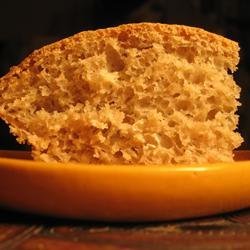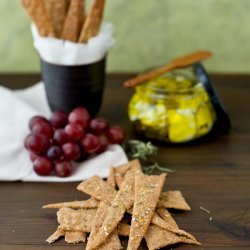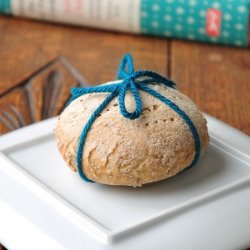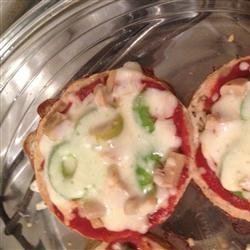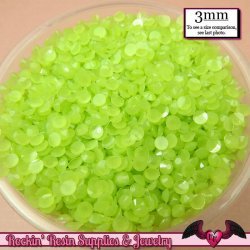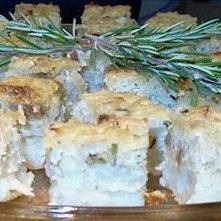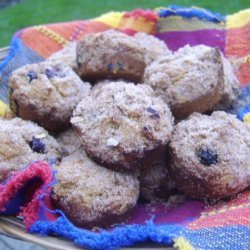Directions:
- Combine the starter and water in a 6-quart bowl. Break up the starter well with a wooden spoon and stir until it loosens and the mixture is slightly frothy. Add the rye flour and stir until well combined. Add the whole wheat flour, salt, caraway seeds, and just enough of the bran flour to make a thick mass that is difficult to stir. Turn out onto a well-floured surface and knead, adding remaining flour when needed, until dough is soft and smooth, 15 to 17 minutes, or make in a heavy-duty mixer. All finished rye doughs will remain slightly sticky. Be cautious about adding too much flour when kneading. The dough is ready when a little pulled from the mass springs back quickly.
- Shape the dough into a ball and let it rest on a lightly floured surface while you scrape, clean, and lightly oil the large bowl. Place the dough in the bowl and turn once to coat with oil. Take the dough's temperature (ideal temperature is 78 degrees). Cover with a clean damp towel or plastic wrap and place in a moderately warm (74 to 80 degrees) draft free place until doubled in volume.
- Deflate the dough by pushing down in the center and pulling up on the sides. Transfer the dough to a lightly floured work surface and knead briefly. Cut into 2 equal pieces. Flatten each with the heel of your hand. Shape each piece into a 12-inch log for long loaves.
- Using 2 well-floured towels and wood blocks, make a couche* in a moderately warm draft-free place. Place the loaves seam side up the couche. Cover with a clean damp towel or plastic wrap and let proof until almost doubled in volume, or until a slight indentation remains when the dough is pressed with the fingertip.
- Preheat the oven and baking stone on the center rack of the oven to 450 degrees, 45 minutes to 1 hour before baking. The oven rack must be in the center of the oven. If it is in the lower 1/3 of the oven the bottom of the breads may burn, and if it is in the upper 1/3, the top crusts may burn. Gently slip the loaves from the couche onto a well-floured peel so that they are right side up. Using a very sharp, serrated knife or a single-edged razor blade, score the loaves by making quick shallow cuts 1/4 to 1/2-inch deep along the surface.
- Using the peel, slide the loaves onto the hearth. Quickly spray the inner walls and floor of the oven with cold water from a spritzer bottle. If there's an electric light bulb in the oven, avoid spraying it directly?it may burst. Spray for several seconds until steam has filled the oven. Quickly close the door to trap the steam and bake 3 minutes. Spray again in the same way, closing the door immediately so that steam doesn't escape. Bake until loaves begin to color, about 20 minutes. Reduce the heat to 375 degrees and bake until loaves are a rich caramel color and the crusts are firm, another 15 to 20 minutes.
- To test the loaves for doneness, remove and hold the loaves upside down. Strike the bottoms firmly with your finger. If the sound is hollow, the breads are done. If it doesn't sound hollow, bake 5 minutes longer. Cool completely on wire racks.
- Note: If the dough temperature is higher than 78 degrees, put it in a cooler than (78 degree) place like the refrigerator, until the dough cools to 78 degrees. If it is lower than 78 degrees, put in it a warmer than 78 degree place until the dough warms to 78 degrees. The point is to try to keep the dough at 78 degrees during its fermentation. If you do have to move the dough, be gentle and don't jostle it, or the dough may deflate.
- *Couche?French for couch or resting place . This is a simple holding device you make yourself for proofing long loaves like logs, torpedo shapes, and baguettes. Using well-floured canvas or linen towels create folds to separate loaves while hold them securely next to each other during proofing. Use a length of fabric at least a yard long. Place 12 to 16-inch wooden blocks cut from 2 by 4's at either long end to contain the loaves. Or substitute large books to contain the loaves.
- Place the chef in a tall 2 to 3-quart flat bottomed, round, clear plastic container with a tight fitting lid. Add the rye flour and spring water, and stir vigorously with a wooden spoon until the mixture becomes thick and pasty. Mark the level of the mixture on the side of the container with a black marking pen. Scrape down, cover tightly, and let stand in a moderately warm (74 to 80 degree) draft-free place until almost doubled in volume, 8 to 10 hours. The mixture will look light and spongy. You can observe the level of sourdough by using the black mark on the side of the container as an indicator. Do not let the sourdough ferment for longer than 10 hours, or the yeast may exhaust itself and the dough may not rise properly. The ripe chef has now produced 18 ounces of ripe sourdough, which you can use in any rye sourdough recipe.
- The Rye Chef: Day 1 1/2 cup (4 fluid ounces) spring water 2/3 cup (3 ounces) organic stone-ground rye flour, preferably medium ground
- In a tall 2 to 3-quart clear plastic container with a tight-fitting lid, stir together the water and flour. Scrape down the sides of the container with a rubber spatula. Cover tightly and put in moderate (74 to 80 degree) place for 24 hours.
- Day 2 1/2 cup (4 fluid ounces) spring water 2/3 cup (3 ounces) organic stone-ground rye flour, preferably medium ground
- Open the container. The young chef will probably show few signs of activity; the mixture will look like cardboard pulp. Don't worry! It's still a young chef. It will, however, have a sweet and musty smell and the beginnings of a tangy taste. Continue building the chef by adding the water and rye flour. Stir vigorously to bring fresh oxygen into the chef and distribute the fresh flour and water. Scrape down the sides, cover tightly and put in a moderate (74 to 80 degrees) place for another 24 hours.
- Day 3 1/2 cup (4 fluid ounces) spring water 2/3 cup (3 ounces) organic stone-ground rye flour, preferably medium ground
- The chef should have expanded noticeably. There should be bubbles on the surface. Taste it; it will have a pronounced sour taste and smell. Hold the container up and observe the large and small holes formed beneath the surface. Stir it with a wooden spoon; you should hear the faint crackle of gas bubbles popping. The chef is very much alive and maturing. Insert the spoon again and lift it up slowly. Short glutinous strands will stick to the spoon. Once again, nourish the chef by vigorously stirring in another addition of the spring water and rye flour. Scrape down the sides, cover tightly again, and return to its moderate-temperature place. Let stand for another 24 hours.
- Day 4 1/2 cup (4 fluid ounces) spring water 2/3 cup (3 ounces) organic stone-ground rye flour, preferably medium ground
- The chef is almost mature and ripe. It has expanded a great deal; maybe almost doubled in volume from Day 3, and it is very lively with bubbles and a well-developed cellular structure. You will see a honeycomb of large and small holes through the clear plastic container. Taste and smell the chef; it is pungent and unmistakably tangy, sour but not bitter. Nourish again with the last addition of spring water and rye flour, stirring vigorously. Using a black marker pen, mark the level of the chef on the side of the clear plastic container. Scrape down the sides, cover tightly, and let stand again in the same place for only 8 hours.
- If your chef was ripe, the mixture should almost double in volume. You can check its growth by comparing the height of the risen chef against the mark you made on the side of the container before the last rising.
- The chef is now ready to use to create your sourdough starter. If you are not going to make the starter immediately, refrigerate the chef in its tightly covered container for up to 3 days.
Nutrition Facts
| Amount Per 1 Serving | |||
| Calories | 8125.12 Kcal (34018 kJ) | ||
| Calories from fat | 814.35 Kcal | ||
| % Daily Value* | |||
| Total Fat | 90.48g | 139% | |
|---|---|---|---|
| Sodium | 21056.34mg | 877% | |
| Potassium | 354.55mg | 8% | |
| Total Carbs | 1686.34g | 562% | |
| Sugars | 3.25g | 13% | |
| Dietary Fiber | 263.79g | 1055% | |
| Protein | 269.42g | 539% | |
| Vitamin C | 0.7mg | 1% | |
| Iron | 79mg | 439% | |
| Calcium | 1573.1mg | 157% | |
| Amount Per 100 g | |||
| Calories | 1670.7 Kcal (6995 kJ) | ||
| Calories from fat | 167.45 Kcal | ||
| % Daily Value* | |||
| Total Fat | 18.61g | 139% | |
|---|---|---|---|
| Sodium | 4329.63mg | 877% | |
| Potassium | 72.9mg | 8% | |
| Total Carbs | 346.75g | 562% | |
| Sugars | 0.67g | 13% | |
| Dietary Fiber | 54.24g | 1055% | |
| Protein | 55.4g | 539% | |
| Vitamin C | 0.2mg | 1% | |
| Iron | 16.2mg | 439% | |
| Calcium | 323.5mg | 157% | |
* Percent Daily Values are based on a 2000 calorie diet. Your daily values may be higher or lower depending on your calorie needs.
Find out how many calories should you eat.
Get Your Recipe of Health!
Follow RecipeOfHealth on Facebook!


